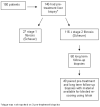Clinical, virologic, histologic, and biochemical outcomes after successful HCV therapy: a 5-year follow-up of 150 patients
- PMID: 19072828
- PMCID: PMC2731713
- DOI: 10.1002/hep.22694
Clinical, virologic, histologic, and biochemical outcomes after successful HCV therapy: a 5-year follow-up of 150 patients
Abstract
One hundred fifty patients with sustained virologic response (SVR) after treatment of chronic hepatitis C were enrolled in a long-term clinical follow-up study; patients were followed for 5 years for liver-related outcomes and evidence of biochemical or virologic relapse. Patients with stage 2 or greater fibrosis on pretreatment biopsy were invited to undergo a long-term follow-up biopsy after their fourth year of follow-up. One hundred twenty-eight patients (85%) were followed through their fourth year, and long-term follow-up biopsies were obtained from 60 patients (40%). Forty-nine patients had paired pretreatment and long-term follow-up biopsies blindly rescored. Forty of these patients (82%) had a decrease in fibrosis score, and 45 (92%) had a decrease in combined inflammation score. Ten patients (20%) had normal or nearly normal livers on long-term follow-up biopsy. Two patients with pretreatment cirrhosis developed hepatocellular carcinoma (HCC), and one died. All the other patients with pretreatment cirrhosis or advanced fibrosis had improved fibrosis scores on long-term follow-up biopsy. No patient had conclusive evidence of virologic relapse. Three patients had persistently elevated alanine aminotransferase levels; two of these had new liver disease.
Conclusion: In a cohort of 150 patients with SVR followed for 5 years, the majority of patients had good outcomes. Serum virologic relapse was not seen, but two patients with pretreatment cirrhosis developed HCC, and one died. In a blind rescoring of 49 paired pretreatment and long-term follow-up biopsies, 82% improved fibrosis scores and 92% improved at least one component of inflammation. A minority of patients had normal or nearly normal liver tissue on long-term follow-up biopsy. Patients with cirrhosis pretreatment are at a low but real risk of HCC after SVR.
Figures













References
-
- Poynard T, Marcellin P, Lee S, Niederau C, Minuk G, Ideo G, et al. Randomised trial of interferon alpha 2b plus ribavirin for 48 weeks or for 24 weeks versus interferon alpha 2b plus placebo for 48 weeks for treatment of chronic infection with hepatitis C virus. International Hepatitis Interventional Therapy Group (IHIT) Lancet. 1998;352:1426–1432. - PubMed
-
- McHutchison JG, Gorelick RJ, Schiff ER, Shiffman ML, Lee WM, Rustgi VK, et al. Interferon Alfa-2b Alone or in Combination with Ribavirin as Initial Treatment for Chronic Hepatitis C. N Eng J Med. 1998;339:1485–1492. - PubMed
-
- Marcellin P, Boyer N, Gervais A, Martinot M, Pouteau M, Castelnau C, et al. Long-term histologic improvement and loss of detectable intrahepatic HCV RNA in patients with chronic hepatitis C and sustained response to interferon-alpha therapy. Ann Int Med. 1997;127:875–881. - PubMed
-
- Lau DT, Kleiner DE, Ghany MG, Park Y, Schmid P, Hoofnagle J. 10-year follow-up after interferon therapy for chronic hepatitis C. Hepatology. 1998;28:1121–1127. - PubMed
-
- Reichard O, Glaumann H, Fryden A, Norkrans G, Wejstal R, Weiland O. Long-term follow-up of chronic hepatitis C patients with sustained virological response to alpha-interferon. J of Hepatology. 1999;30:783–787. - PubMed
Publication types
MeSH terms
Substances
Grants and funding
LinkOut - more resources
Full Text Sources
Other Literature Sources
Medical
